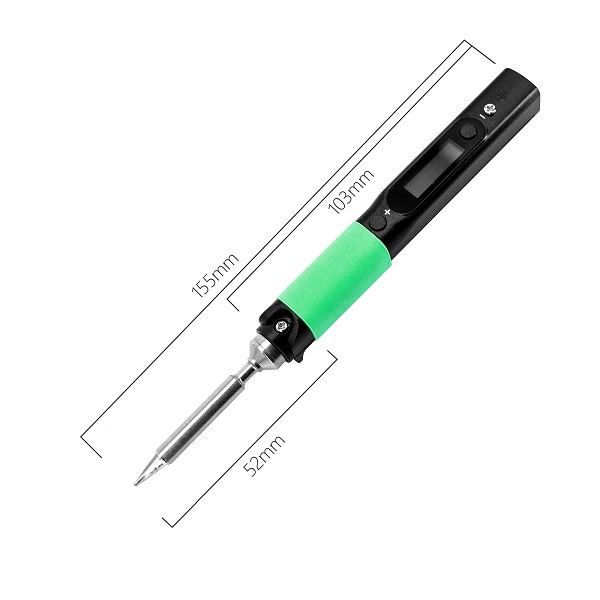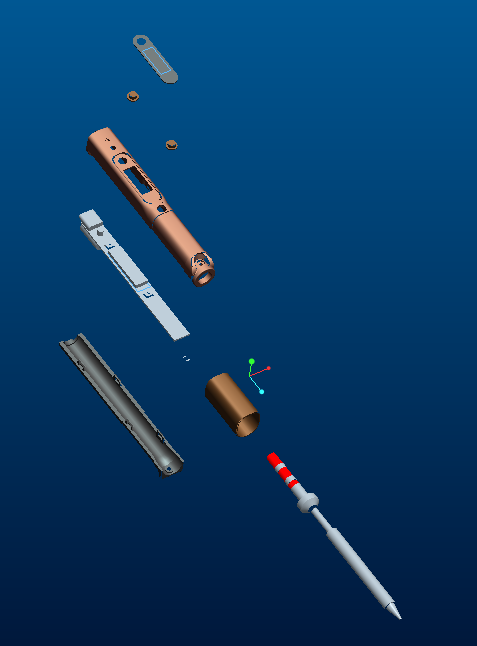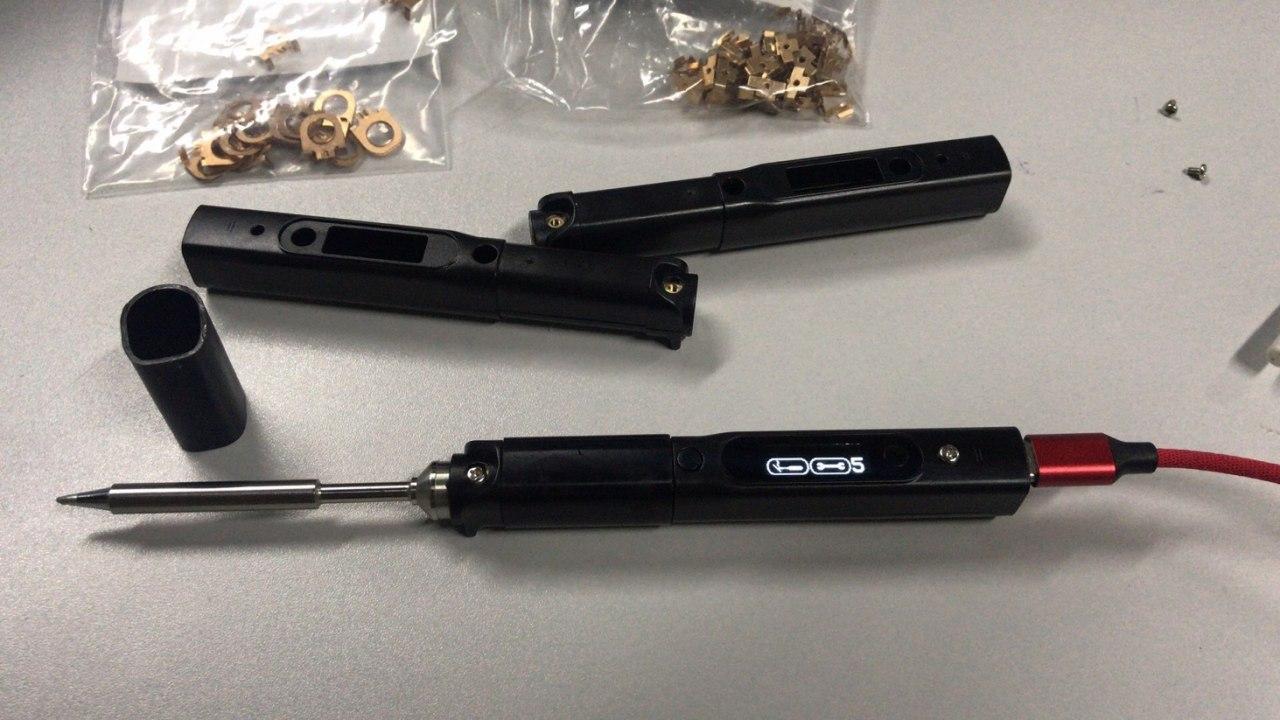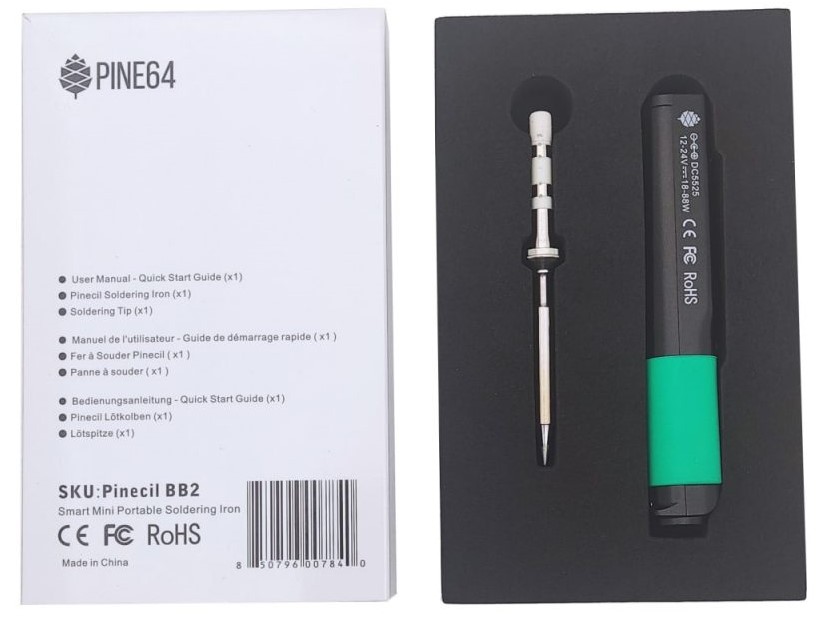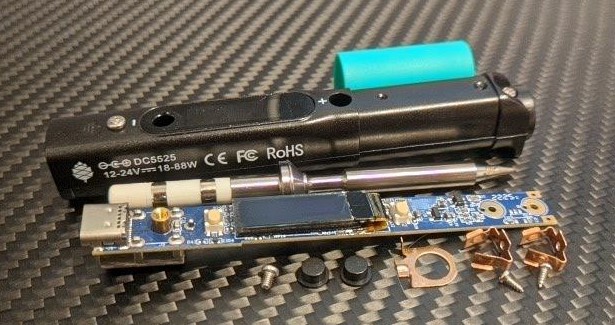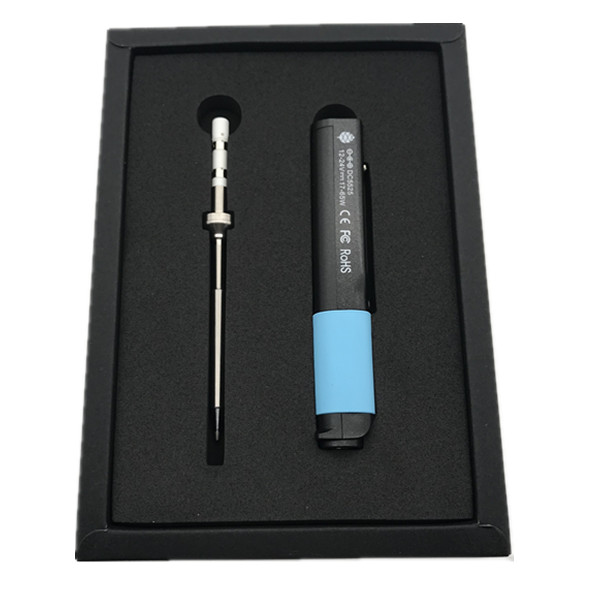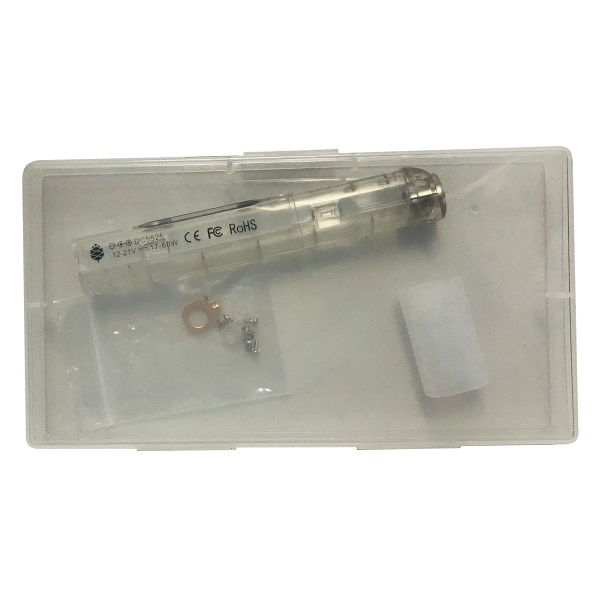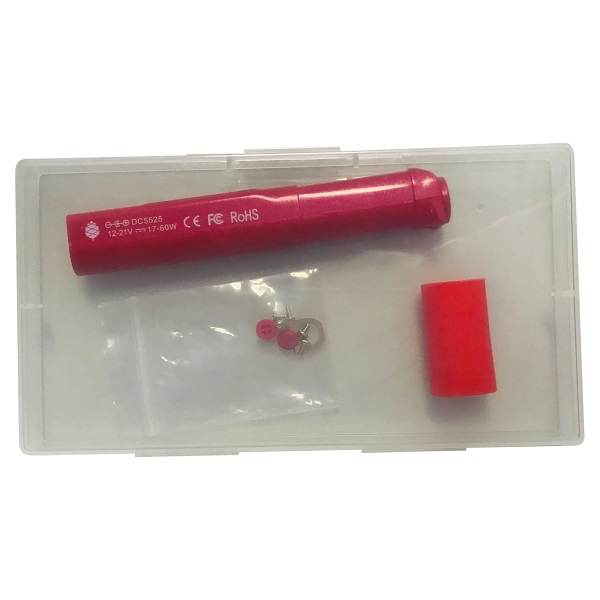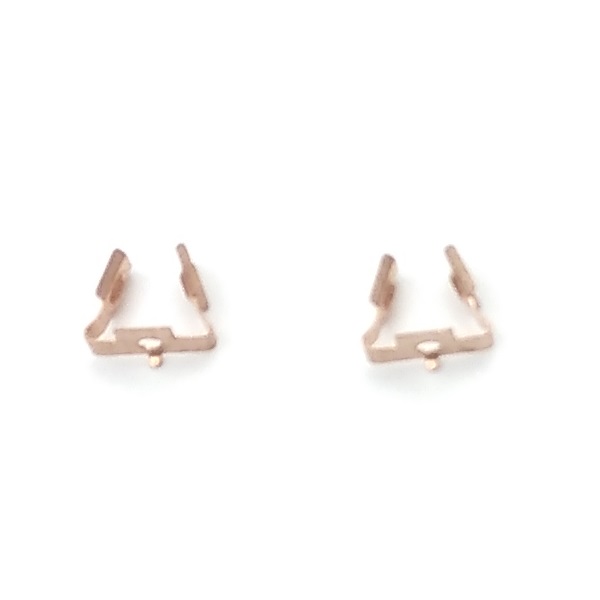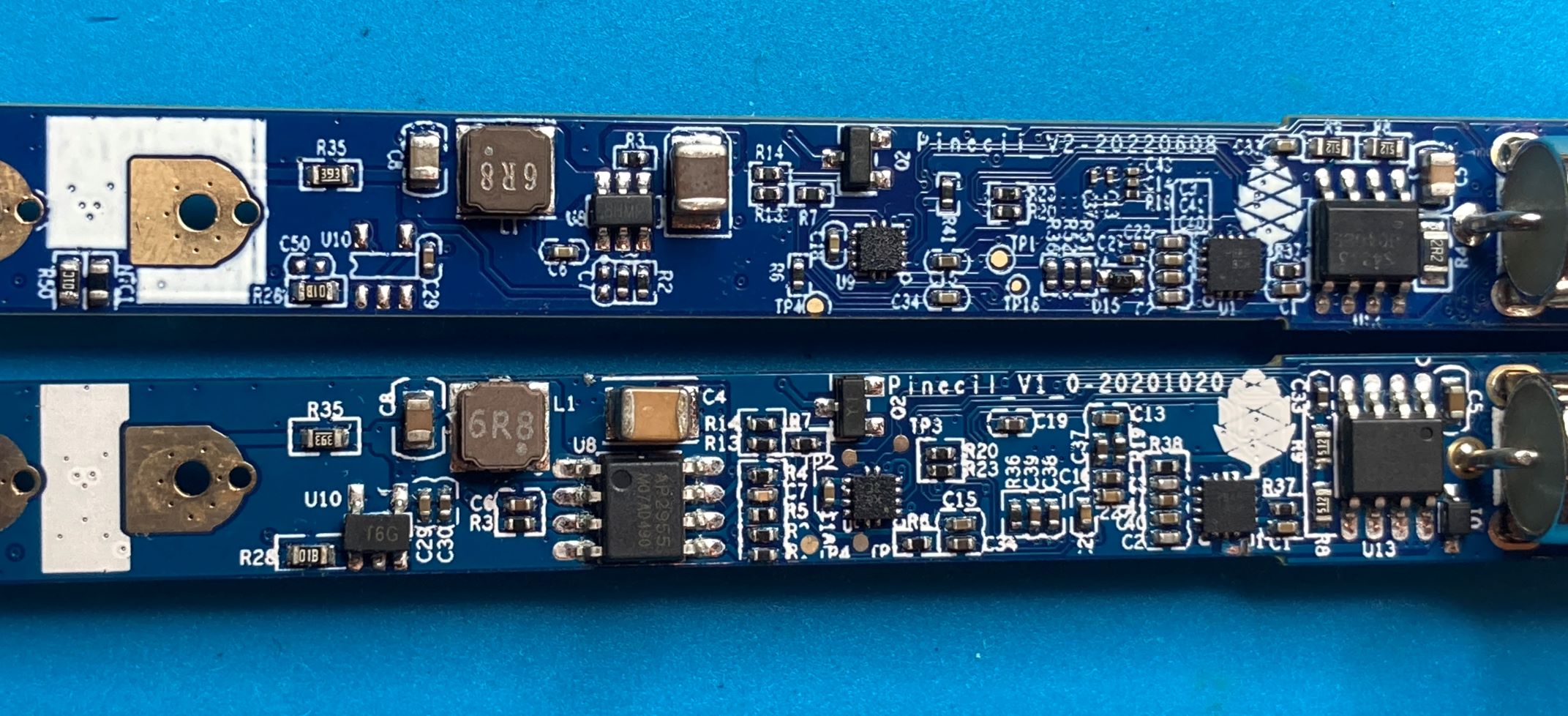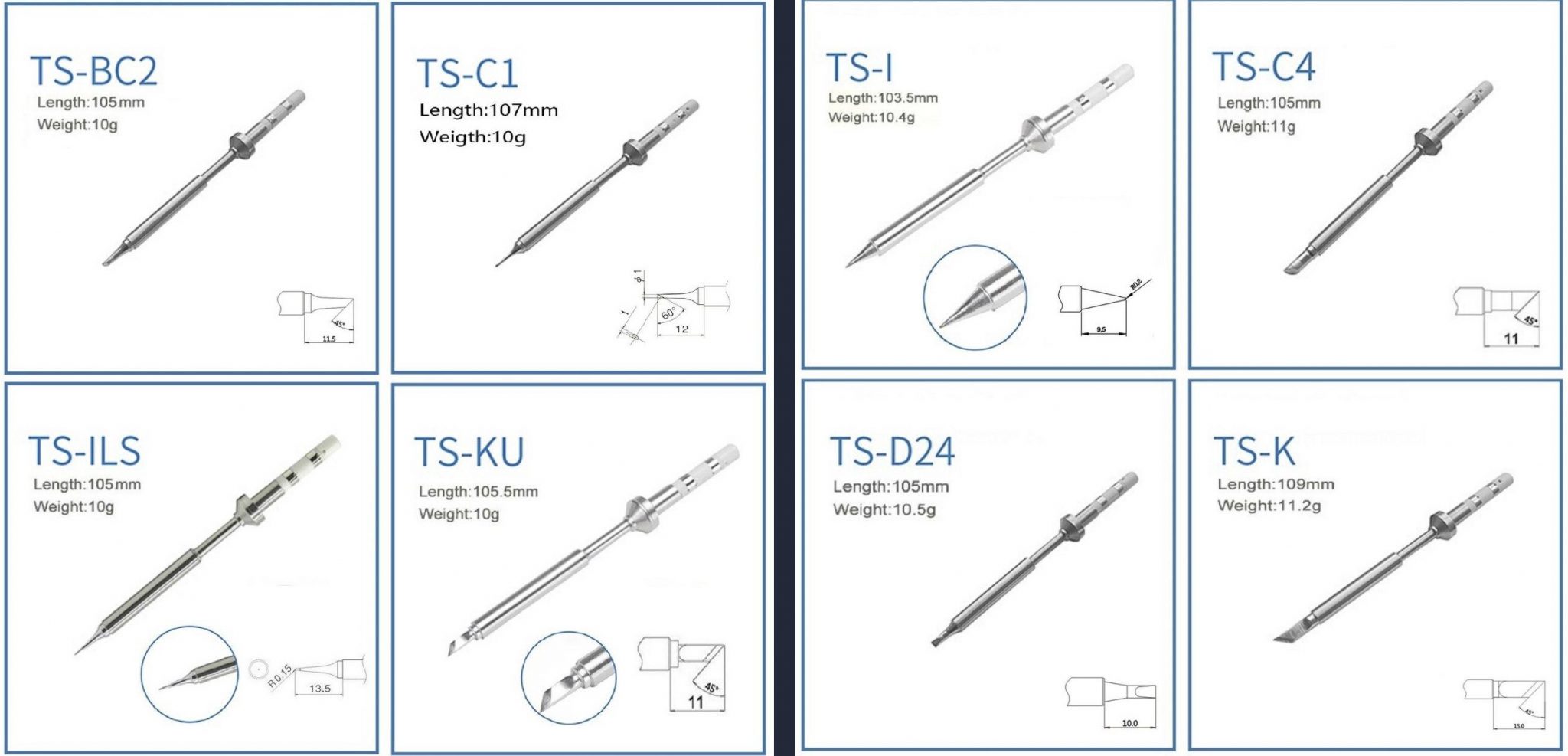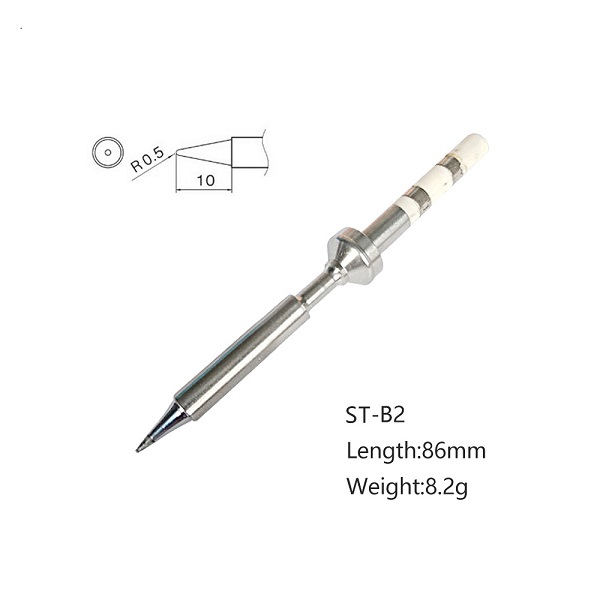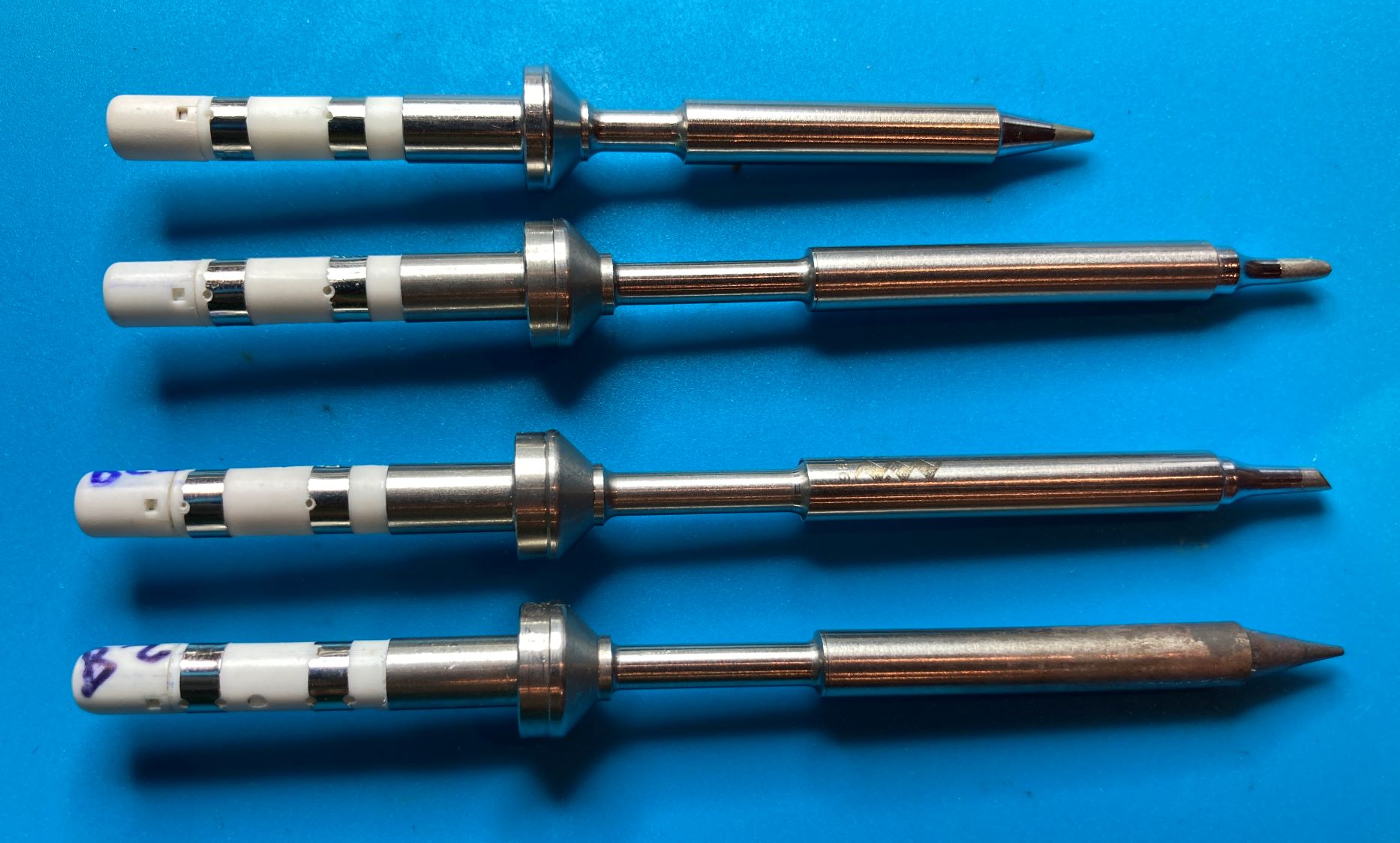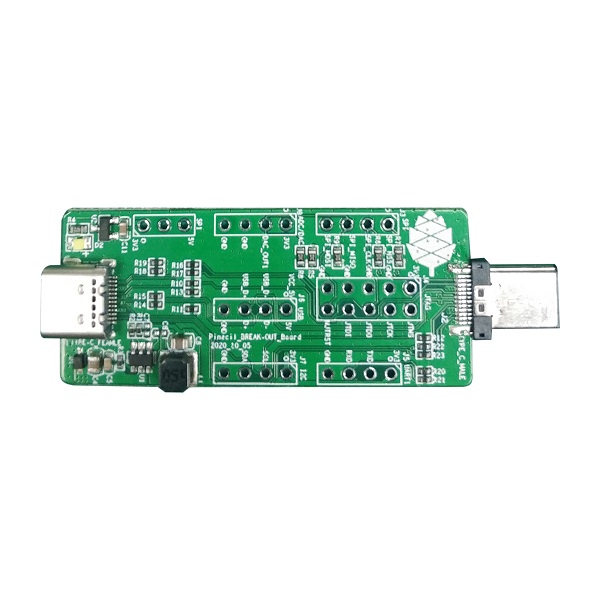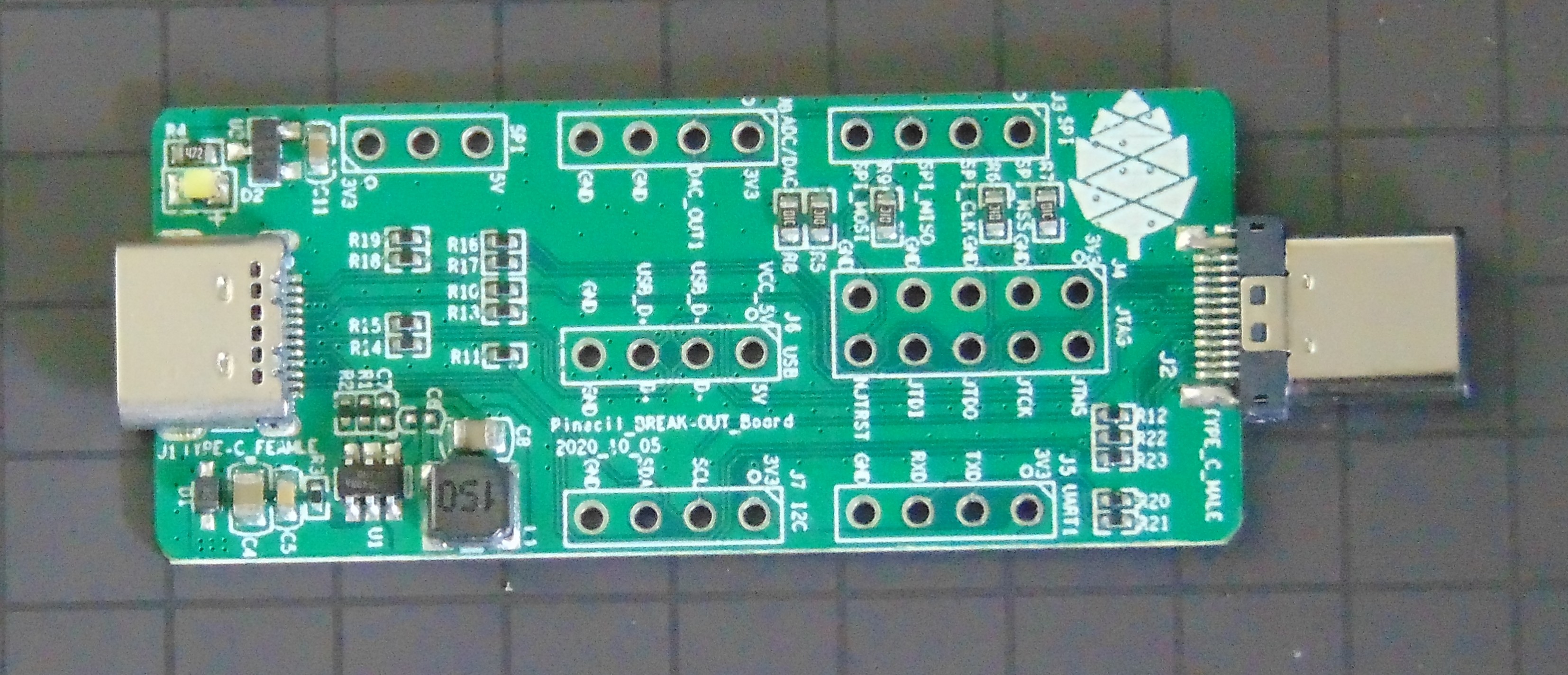Pinecil
The Pinecil is a portable, temperature controlled soldering iron. It also has the intended use of being a Risc-V development device using a breakout board.
Authenticity
- Portability
- Settable temperature
- Soldering tips:
- Replaceable
- Many styles available. Currently sold as 2 separate sets of 4, one fine set, the other larger.
- Compatible with TS100
- Flexible power sources:
- DC 5525 Barrel jack
- USB Type C power delivery
- Battery: 3S/4S/5S LiPo batteries or 18V-20V Lithium-ion tool batteries
- Pinecil V2 has a BL706 chip, see batch changes below.
- Pinecil V1 has the GD32V Development platform.
- Board schematics are open. Software is open. Create your own!
- Pinecil breakout boardlets you use JTAG, GPIO, A2D, SPI, and more.
There are additional features that include (Useful for devkit use):
- A Programmable Gigadevice Risc-V GD32VF103 embedded processor
- 0.67" Monochrome Display that can render text or graphics
- Support for Idle detection, for automatic power down of tip
- Programmable with tools from Gigadevice, HomeBrew or Linux RISC-V.
There are no Pine64 Pinecils sold on AliExpress. They are not made by Pine64. There are no authorized resellers on AliExpress. Some manfacturer has copied the Pine64 company name, trademark and Pinecone logo and is selling a product made to look like Pinecil through many store fronts, but it is not a Pinecil. They use a different type of box, i.e., a blue or red box and sell colors that Pine64 never made. They are all fake copies and do not go through the same QC as Pine64. It is unclear what type of chips or poor quality cloned chips are used in them. They are not recommended. Genuine Pine64 Pinecil comes in a black color and has a silicone thumb grip (sky blue V1, teal green V2).
Pinecil V2 Authenticity Checker
Pinecil V2, released Aug. 2, 2022, uses a different chipset from V1. Each V2 comes with a unique internal ID/Serial number. If you want to check if your Pinecil V2 is Authentic, go here:
Pinecil V2 Authenticity Checker
Where to buy a Pinecil
PINE64 Official Stores
- Global PINE64 store (ships from China)
- Amazon-USA official pine64 store (ships from USA)
PINE64 EU
- PINE64 EU store (ships from EU)
Official affiliates
- AmeriDroid (ships from California, USA)
Other sites selling real Pinecil
- Eleshop.eu (ships from EU)
Usage
Overview
- Install the Tip: pinecil comes with a separate heating element, the tip, which needs to be installed.
- Remove the front top-side tip screw. Then, gently instert the tip into the front of the handle and push it all the way in so that the wide collar guard is touching the front of the plastic (see photo).
- Lightly tighten or loosen this one screw to install or swap the tip. (careful, tiny screws break easy, if tip does not fall out, it's tight enough)
- The bottom front screw should not touch the tip, it only holds the handle together.
- Supply Power: the USB-C port, connected to any supply, is enough power to show the display screen, but not necessarily enough to heat the tip.
- USB2 port at 5 volts (i.e., laptop) shows DC Low, this is enough for firmware updates and to view the menu, but not to run the soldering iron.
- See Power section for details on power for Pinecil.
- Heat the Tip: plug Pinecil into an appropriate power supply.
- Clicking
[+]starts the tip heating. - The display then shows power draw, current temperature, supply voltage, and estimated time to reach target temperature.
- Adjust the target temperature with further clicks of
[+]and[-]buttons. - Waiting for the regular display to return, then holding down
[-]for a moment turns the heat off. - You can observe the temperature measurement go up and down. Certain settings involve holding down both buttons (see Github IronOS for details on firmware settings).
- Clicking
- Using the Settings Menu:
- To check the firmware version, hold down the
[-]button. It will display something like "v2.14.2425902 17-01-21"- This is the firmware number and release date, the date is Jan. 17, 2021 in the example.
- Clicking
[-]when heat is off steps through main categories menus to control a variety of settings, see Getting Started section. - Clicking
[-]also returns to the regular display of temperature, and supply voltage (this view varies if you activate detailed idle). At other times it may show power draw. - Click
[-]to scroll to the the main menu section desired (i.e., User Interface). Then Click[+]button to change various internal settings. Then click [-] again to go to the next item in the sub-menu.
- To check the firmware version, hold down the
- Important notes:
- The iron will "sleep", switching to a lower temperature, after it has been put down for a short time, and heat up again when it is picked up.
- For Safety, unplug the soldering Iron when not in use or left unattended.
- To heat up the tip, we need a power supply that can provide at least 12V to run. This is the minimum, and Pinecil will heat slowly at only 12V. To maximize performance, higher Volts/Amps/Watts is recommended (see Power Supply section).
- Option 1: a USB-C supply that can negotiate up to such a voltage. For maximum performance and good soldering experience, a USB-C PD65W/20V/3+amp charger is recommended (suitable for most users).
- Option 2: a supply with a standard DC 5525 barrel connector (+ pos center, - neg outside) that supplies anywhere from 12V to 21V (V1 Pinecil) or 12V-24V (V2 Pinecil).
- Option 2: use a battery, i.e., an 18V-21V tool Battery with a Power Wheels adaptor, and a cable to plug into the Pinecil DC5525 barrel jack.
- You may have a suitable supply already that could be used, (see Power Supply section below).
- See warnings about using random DC barrel chargers, not all of them have the correct polarity or DC 5525 style plug and some may be too high of voltage which could damage the Pinecil.
- While 12V will work, it will not heat the tip as quickly and efficiently as a PD65W/20V usb-c charger or a higher rated DC barrel charger.
Getting Started
- Getting Started guide in Github/IronOS
- Main Settings Menu: updated list is found in the firmware repository IronOS Settings Menu
- Power settings: settings related to power, battery cells, input voltage.
- Soldering settings: settings for soldering such as, boost temps, increments for temperature change
- Sleep mode: power & tip saving, such as sleep mode, sleep temperature, and shutdown modes, motion sensitivity
- User interface: settings such as, units C/F, display orientation, button reversal, animation speed, brightness, boot logo duration
- Advanced settings: assorted catchall for settings that don't fit elsewhere or settings that require some thought before use. Restore factory settings is here. It will not change the firmware version, but rather resets the menu back to IronOS defaults. This is good to do after a major firmware update as settings may have been altered and need to be re-selected/customized again to work as expected.
- Hidden Debug Menus: also available, see Githum/IronOS
- Advanced Modifications: Installing Optional Hall Effect Sensor
Community links
- Want to hang out with other PINE64 Pinecil owners or the PINE64 open source community?
- Need troubleshooting advice on pinecil?
Join one of the Community Chat links
Specifications
Pinecil V2
- Package: 15cm x 9cm x 2.2cm, white box (released Aug 2, 2022)
- Dimensions: 155mm with solder tip or 103mm without solder tip x 12.8mm x 16.2mm
- Weight: 28g with solder tip, 18g without solder tip
- Platform: Ralim's IronOS build
- Chipset: Bouffalo BL-706
- CPU: 32-bit RV32IMAFC RISC-V “SiFive E24 Core” @ 144 MHz
- Display: OLED White Color Monochrome Display 0.69" 96x16 pixels
- Memory:
- 192KB Internal Flash
- 132KB SRAM System
- Tip: type ST-B2, (short tip) Soldering tip, Length 86mm, weight 8.2g
- Power Ports (12V-24V, 88 Watts):
- Only use one power port at a time (usb or DC barrel)
- USB type C: PD 12V-20V 3A and QC 3.0 12V-20V 3A (magnetic tip USB-C cables are not recommended, and not USB compliant)
- Barrel Jack: DC5525, 12V-24V, minimum 3amps.
- Trying to use an incorrect barrel jack, i.e., DC5521 will BREAK the connector (if it doesn't go in easy, it doesn't fit).
- Recommend operating voltage 12-24V, but a 12V USB-C charger will not perform as well or heat as fast as a USB-C PD65W/20V/3amp charger.
- Tentative support: EPR 140W/28V PD3.1 chargers + EPR cables are theoretically supported in hardware and IronOS firmware.
- EPR is new technology in 2022. Theoretically Pinecil could get a max of 28V and 126W using EPR chargers & EPR cables (natural loss of 140W to 126W due to Tip ohms).
- Bleeding edge users are using/testing this.
- EPR is potentially the fastest/highest performance possible for V2; officially Pine Store states 12V-24V, 88W.
Pinecil V1
- Package: 16.8cm x 11.8cm x 2.3cm, black box with clear plastic front (sold before Aug 2, 2022)
- Dimensions: 170mm with solder tip or 98mm without solder tip x 12.8mm x 16.2mm
- Weight: 30g with solder tip, 20g without solder tip
- CPU: GD32VF103TB 32-bit RV32IMAC RISC-V “Bumblebee Core” @ 108 MHz
- Display: 0.67" QUG 9616TSWCG02 96x16 Monochrome Matrix display
- Memory:
- 128KB Flash
- 32KB SRAM
- Power supply (12V -21V, 65W):
- Only use one power port at a time (usb or DC barrel)
- DC 12V-21V 5525 Barrel Jack. Do not try to use a larger 5521 (which requires excessive force). It will BREAK the connector.
- USB-C 12-20V PD or QC3.0 (magnetic tip USB-C cables are not recommended, and not USB compliant)
- Recommend operating voltage 12-21V, some components can tolerate higher voltages at "absolute maximum" but it's very ill-advised
- Fasteners used(source)
- Originals are Phillips screws: two M2x3mm at the front tip, and one M2x4mm is the ground screw next to the (-) minus button.
- Alternate screw replacments, M2x4mm Thumb screw can replace the Top side Tip holder screw.
Manuals
Firmware
The official firmware that comes with the Pinecil is open source IronOS. It's a good idea to check for updates regularly as development is very active and there may be enhancements or new bug fixes available.
- Hold down
[-]to see the firmware version - Firmware update instructions
- To explore documentation on Menu or settings, submit a feature request, or help Ralim enhance the code, see GitHub Ralim/IronOS
- One advantage of Pinecil (V1/V2) over other irons (i.e., Miniware) is you can not really brick them since Pinecil's bootloader is in rom. If there is a problem, just flash the firmware again or a different version. This empowers people to experiment and do forks of the main IronOS firmware.
- See Community Chat Links if you run into issues updating.
Development efforts
| Project Homepage | Description | |
|---|---|---|
| Ben Brown
(ralimtek) |
Github Ralim/IronOS | Official Pinecil firmware |
| Alvin Wong | alvinhochun/gd32vf103-pinecil-demo-rs | Rust code demos for Pinecil |
Disassembly steps
Video of Alternate Method for opening Pinecil here.
- Recommend to take photos to help with reassembly.
- Remove the Tip.
- Let tip cool down.
- Loosen the top tip screw (PH1) (top is display screen side).
- Gently pull the tip out and set aside.
- Slide rubber thumb grip off towards the tip side.
- Remove the bottom screw (at the tip, between the feet) (PH1).
- Remove the ground screw (longer screw on the top side near the (-) button) (PH1).
- Slightly pull the two halves of the case apart at the tip front end, enough to get a fingernail or guitar pick between the halves.
- Move the pick down the length of the split to loosen the bottom half's clips from the top half of the case.
- Once loose, remove the bottom half by moving it forward (it is retained by the top half at the port side).
- Remove the screws retaining the copper tip contacts (PH000, M1.4 x 5), and note the direction.
- Remove the copper tip contacts.
- Flip the Pinecil over and the PCB should fall out, or it could be lifted gently up from the DC barrel end.
- The two small buttons are now loose, carefully set aside the top half, or remove the buttons so they do not get lost.
Assembly steps
- Place the key caps into their recesses in the top half of the case.
- Place the PCB assembly into the top half of the case ports first.
- Lower the rest of the board into the case and move the PCB assembly towards the port side of the case (the DC barrel connector may be a firm place to gently push).
- Install the copper tip contacts.
- Orient the contact to align the alignment pin with the alignment hole next to the big hole on one of the big gold pads.
- Install and gently tighten the PH000 screw until the clip is no longer loose.
- Place the bottom half of the case into the top half by sliding the lip on the port side (side without the feet) of the bottom half under the arch of the port side of the top half.
- Gently close the case by bringing the two halves together, paying attention to each clip's alignment and ensuring the case edges align.
- Install the short PH1 screw at the bottom of the tip side of the case.
- Install the longer PH1 screw at the ground connection point at the top side of the case (between the display and the ports).
- Slide the rubber sleeve on (larger ridge first).
- Gently insert tip.
- Gently tighten the top PH1 screw to retain the tip.
Checklist
Upon receipt, or buying a used Pinecil, one may want to check the following:
- the display turns on when 5-24V is supplied (5-21V for older V1 models).
- via USB type C or DC 5525 center positive barrel (check polarity)
- caution: do not plug in both USB-C and DC5525 at the same time. This will destroy devices, posibly your laptop/pc.
- The two ports are intended to be used indenpendently and not at the same time.
- note that 5v shows DC low and is not high enough to run Pinecil. 5V is only enough for firmware update and to see the menu.
- it gets 20V from a 20V capable USB-C PD charger
- check both orientations of the type C cable (try to flip it)
- Check Update mode (see Ralim/IronOS for details on flashing)
- requires a data capable USB cable connected to a laptop or some appropriate device.
- to enter update mode, hold down
[-](button near back/ground screw) while plugging in USB cable. - screen is black/blank if you are correctly in update mode. This can be tested even if you are not updating the firmware.
- note: only plug in USB-C cable when doing Update mode, there should be no DC barrel connected at the same time.
- both buttons work
-to enter menu or decrease temperature, long press to get software version info or to turn off heating+to turn on heating or select a menu item
- the displayed text rotates according to gravity when orientation is set to Automatic
- menu -> User interface -> Display orientation -> Automatic
- More menu options listed on Github/IronOS
- all 3 external screws are present
- one near the back near the screen (ground screw)
- one at the front on top (to hold the tip in)
- one at the front on the bottom (to hold the case together)
- the tip is clean (uniformly silver at the front, with no pitting or texture)
- see #Caring for a soldering iron in case it is used
- it heats up an installed tip, and stops increasing when it reaches the set point
- this may draw up to ~3A, make sure the power supply can provide that
- minor overshoot may occur, but, disconnect power if the temperature keeps going up
- the reported temperature is correct
- if no direct measurement is possible, set it to ~230°C and see if it melts SAC (lead-free) solder (~190°C for leaded)
- if there are multiple tips, check all of them
Pictures
Pre-release:
Production:
PCB:
Pinecil tips
- Uses TS-100 compatible tips and ST Short Tips
- Uses Pine64 new design shorter 6.2 ohm tips
- Pinecil V1 includes tip model TS-B2.
- Pinecil V2 includes tip model ST-B2 Short tip.
- Fine Tip set 1 (left) & Gross (large) 2 (right):
Common resistance for tips, from top to bottom:
- Pine64 short tip 6.2 ohm, new
- no brand long tip 7.9 ohm, new
- Miniware long tip 8.0 ohm, new
- no brand long tip 8.3 ohm, lightly used
The shorter tip is designed for higher performance. For example with a PD65W-20V charger, the max watt with an 8ohm tip is 50W, and the max watt with a 6.2 ohm tip is ~64 watts (watts/volts calculator).
Cases and 3D Models
- Pinecil compact case
- Pinecil and tips case
- 3D model of Pinecil by kohkoh
- T12 tip adaptor to protect internal Mosfet in Pinecil
- T12 tip adapter for outside tip holding
- Thingiverse search for 'Pinecil'
- Multipart Pinecil Case by Pjotrke
Caring for a soldering iron & guides
Guides to Soldering
- Ultimate soldering guide
- Beginner's Guide to Soldering - Mr. Solder
- Working with Lead-free solder
- How to Solder SMD & Small Components - Mr. Solder
- Fine SMD Soldering
- Melt Points for No-Lead & Leaded Solder
Solder Tip Maintenance
What type of Solder and Flux Should I Get?
Batch changes
- On Aug. 2, 2022, Pinecil V2 was released with improved hardware & accesories. It retains the same ergonomics and design as the original Pinecil, and will work with any accessories you already have including existing cases and tips. It comes with a teal color silicone grip versus the sky blue finger grip from Pinecil V1. It also includes one of Pine64's newly designed shorter 6.2 ohm tips. By reducing the tip resistance from 8 to 6.2 ohms, it allows greater performance and and faster heating (64W @ 20V compared to 8ohm tips which allowed a max of 50W to Pinecil). Pinecil V2 is rated for 12V-24V.
- Key changes in V2: new processor (BL706), higher maximum input voltage (24V), tentative support for USB-PD EPR (28V), support for measuring tip resistance, allows automatic detection of 6.2 vs 8 ohm tips. A notable improvement is the new BL706 RISC-V processor from Bouffalo. It is similar to the BL602 in the Pinenut. The BL706 features Bluetooth Low Energy (BLE); so future IronOS firmware releases will work to expose features over BLE. This is not trivial work, but as people contribute to the opensource code of Github/IronOS, the BLE will be expanded.
- Things staying the same in V2: V2 still uses a RISC-V processor, but adds noticeable upgrades to the hardware. GPIO is broken out on USB-C for creating your own projects, same pinout as Pinecil V1, same great feel, including the rubber grip, works with all existing tips, same DC input + USB-C input connections, same case as V1 and compatibility with the clear/black/red cases.
- For the first manufacture batch (October 2020, order number 158xxx) of the Pinecil, the copper ring connecting the earth screw to the tip was omitted as the engineering team found the TS100 design lacking. For the second round onwards, an improved design copper ring has been included as standard, and is also included with the replacement clear and black handles. For normal operation of the iron, omission of the ring does not impact it's operation. If you are working with ESD components, you will need it in order to ground the iron tip via the earth screw at the back of the iron.
- The first batch of Pinecil's were rated 12-24v @ 65W. After some heated discussion on the discussion group, it was decided that it would be downgraded to 12-21V @ 60W, due to concern over the connection of the DC jack to the USB-PD chip, which has a recommended maximum of 21v, and absolute maximum of 28v.
Pinecil board information, schematics and certifications
- Pinecil V2 mainboard schematic:
- Pinecil V2 certifications:
- Pinecil V1 mainboard schematic (V1 was sold pre- Aug 2, 2022):
- Pinecil mainboard schematic ver 1.0 20201120, this is production version schematic
- Pinecil mainboard ver 1.0 PCB Component Placement Top PDF file
- Pinecil mainboard ver 1.0 PCB Component Placement Bottom PDF file
- Pinecil mainboard ver 1.0 PCB Component Placement Top Drawing file
- Pinecil mainboard ver 1.0 PCB Component Placement Bottom Drawing file
- Pinecil V1 certifications:
- Pinecil breakout board schematic:
- Photos:
Datasheets for components and peripherals
- GigaDevice RISC-V SoC information:
- Display Module information:
- USB Type-C PD Controller information:
- Sensor information:
- Power Regulator information:
- Power MOSFET Switch information:
- OP Amp information:
Power Supply Compatibility
- Pinecil can either work with a 12-21V battery or power supply via the DC barrel 5525 (5.5mm outer diameter, 2.5mm post) center-positive jack, or with any USB-C power supply that supports the USB-PD (Power Delivery) specification or QC2, QC3.
- Note that QC2 and most QC3 power supplies will only be able to provide at most 12V, limiting the Pinecil to about 17W of thermal capability which is weak and slow.
- USB-C PD type power supply / power bank that is 20V+/65W, allows the Pinecil to deliver the full 60W of heat to soldering tip.
- USB PD type power supplies with at least 20V+/65W+/3amp+ is highly recommended (higher V/W/A will work too as long as it's PD type).
- Magnetic tip USB-C cables are not recommended, and not USB compliant
- Troubleshooting QC chargers: some QC power adapters only allow a limited time for QC negotiation, otherwise voltage will fall back to 5V.
- To address this, starting from firmware v2.16+, there is a PD timeout setting (in 100ms steps) which allows QC negotiation to start earlier. Change this only if you are having issues with your QC charger. (Power Settings > PD timeout)
- This enables some QC adapters to work (i.e., some Baseus QC chargers). Alternately, lowering the number may result in problems with PD negotiation on some PD type adapters that are slower to negotiate. If you switch between QC & PD adaptors, you may have to change this setting.
- For certain QC adapters, lowering the PD timeout value to 15 could help, and most PD adapters will also still work using 15. If a PD charger does not work at 15, then increase the timeout (PD defaut is 20 = 20x 100ms = 2 seconds). Note that some QC chargers simply will not work, are too weak, or cheaply made.
- To address this, starting from firmware v2.16+, there is a PD timeout setting (in 100ms steps) which allows QC negotiation to start earlier. Change this only if you are having issues with your QC charger. (Power Settings > PD timeout)
- Always check polarity of DC Barrel jack before plugging in a random charger or it could break the Pinecil.
Small sample of Known working PD/QC/Barrel power adapters / power banks include:
Power adapter:
- PinePower Desktop w/Grounded 3-pin plug (PD@20V)
- Apple 140W 28V EPR charger with certified EPR Cable (PD@28V, PD@20V) works for V2 or V1
- USB-C Certified EPR cable 240W/40Gbps backwards compatible works for V2 or V1
- Baseus PD65W w/Grounded 3-prong plug (PD@20V)
- HTC PD65W, 3-port black (PD@20V)
- HTC PD65W, 3-port, white (PD@20V)
- Notebook AC Adapter HP L30757-002 (PD@20V)
- Notebook AC Adapter Lenovo ADLX65YLC3D (PD@20V)
- Nintendo Switch AC Adapter (USB-C wall-wart) (PD@15V)
- Ankosen 65W USB C Charger for Mac Book and Laptop Fast Wall Charger, GaN PD3.0
- Nekteck 60W with PD60 cable
- Amazon Basics 65W One-Port GaN USB-C PD 3.0 (https://www.amazon.com/gp/product/B087MD5MYH)
- Charger Harbor SAIL01 65W Dual USB-C Power Delivery GaN PPS $12.99 (https://www.amazon.com/dp/B097CVQ868)
- Baseus GaN2 Pro Quick Charger 100W (CCGAN100UE) (PD@20V)
Adapters:
- Elecjet AnyWatt SQ, USB-C to Lenovo Square Slim-Tip Adapter 45W or 65W, used with a 65W Lenovo Supply (PD@20V, Pinecil shows 64W)
Power bank:
- Blitzwolf BW-P1 10400mAh QC2
- Insignia 80W 26,800mAh NS-PWLB80
- Baseus BiPow 10000mAh 18W PD&QC3.0
- Intenso 7332330 Powerbank PD 10000 - External Battery PowerDelivery & QuickCharge3 - 10000mAh Powerbank, the Pinecil shows 12V and about 17W when heating up, using USB C PD (Red Silicone Pinecil cable)
- Marbero M87 30W PD 3.0
- Charmast C2032 65W Power Bank, maximum power at 20V is only available from the IN/OUT usb C port, the OUT usb C port delivers only 12V.
Limited usability:
- Notebook Docking Station HP Thunderbolt Dock 230W G2 (PD@20V)
- (had problems with lower firmware versions, but works fine Pinecil firmware: 2.15 and DockingStation firmware: 1.0.69.1)
- Smartphone Charger Samsung EP-TA20EWE (QC2@9V)
- Smartphone Charger Google Pixel G1000-US (PD@9V)
- Notebook AC Adapter Delta Electronics ADP-65JH BB (DC@19V) and ADP-90CD DB (1.7x 4.8mm need adaptor, tip is not DC5525)
- Notebook AC Adapter LITEON PA-1700-02 (DC@18.5V, 65W) (tip is 1.7mmx5.5mm would need adaptor for DC5525)
- Nillkin 63W USB Car Charger Quick Charge 3.0 PD (Pinecil Firmware: 2.14.2425902)
- QC3@9V/12V and PD@15V work, PD@20V doesn't
- PD@20V works fine when using PDC004-20V or ZY12PDN on dc jack (DC@20V, limit: 45W)
Not compatible:
- Smartphone Charger RAVpower 30W Dual USB Turbo Wall Charger (Should provide QC3@9V/12V, but only provides 5 V on both ports)
- Sabrent HB-B7C3 USB3 hub, 7 data ports, 3 charge ports, 60W supply -- does not negotiate higher voltages.
